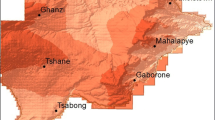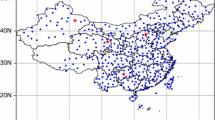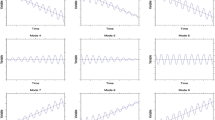Abstract
Four mean temperature variables, namely maximum (MAX), minimum (MIN), mean (MEAN) and diurnal temperature range (DTR), were considered for 14 selected observational stations throughout Sudan. The objectives were to investigate the seasonal and annual regimes, the seasonal and annual trends, the intra-annual variability (IAV) by the coefficient of variation (CV), and the inter-relationships between the temperature variables and percent of possible sunshine. A mounting evidence of daytime and nighttime warming since the 1940s until 2005 is presented. The exception is the dry season which is dominated by daytime cooling attributable to the damping effect of dust haze/storms. Apparently, the progressive drought across inland locations has raised the MAXs, and to a lesser extent the MINs, of the wet season over those for the hot season. Accordingly, maximum rates of 0.451 and 0.336°C decade−1 were found for the nighttime and daytime temperatures, respectively. The extreme eastern and western locations have been frequently dominated by the warmest trend rates obtained nationwide. The prevalence of significant decreases (increases) of DTR is more apparent in the dry, hot and annual series (wet series). Depending on the temperature variable under consideration, many stations possessed significant trends toward either increased or decreased variability of the within-year monthly values, i.e. IAV. The correlation between the time series of annual CV and extreme values for each of the four temperature variables shows generally that warmer climate in Sudan is associated with higher intra-annual temperature variability and vise versa, i.e. the CV is directly correlated with the highest value within the year, but inversely correlated with the lowest one. The findings of this investigation also indicate that the DTR is directly related to percent of possible sunshine, but the relationship of the latter parameter is not so clear with MAX, MIN and MEAN.







Similar content being viewed by others
References
Aguilar, E., A.A. Barry, M. Brunet, L. Ekang, A. Fernandes, M. Massoukina, J. Mbah, A. Mhanda, D.J. do Nascimento, T.C. Peterson, O.T. Umba, M. Tomou, and X. Zhang. 2009. Changes in temperature and precipitation extremes in western central Africa, Guinea Conakry, and Zimbabwea, 1955–2006. Journal of Geophysical Research 114: D02115. doi:10.1029/2008JD011010.
Al-Fahed, S., O. Al-Hawaj, and W. Chakroun. 1997. The recent air temperature rise in Kuwait. Renewable Energy 12(1): 83–90.
Ayoub, A.T. 1999. Land degradation, rainfall variability and food production in the Sahelian zone of the Sudan. Land Degradation and Development 10: 489–500.
Conway, D., C. Mould, and W. Bewket. 2004. Over one century of rainfall and temperature observations in Addis Ababa, Ethiopia. International Journal of Climatology 24: 77–91.
Dai, A., K.E. Trenberth, and T.R. Karl. 1999. Effect of clouds, soil moisture, precipitation, and water vapor on diurnal temperature range. Journal of Climate 12: 2451–2473.
Dessens, J., and A. Bücher. 1995. Changes in minimum and maximum temperatures at Pic du Midi in relation with humidity and cloudiness. Atmospheric Research 37: 147–162.
Durre, I., and J.M. Wallace. 2000. Dependence of extreme daily maximum temperatures on antecedent soil moisture in the Contiguous United States during summer. Journal of Climate 13: 2641–2651.
Easterling, D.R., B. Horton, P.D. Jones, T.C. Peterson, T.R. Karl, D.E. Parker, M.J. Salinger, V. Razuvayev, N. Plummer, P. Jamason, and C.K. Folland. 1997. Maximum and minimum temperature trends for the globe. Science 277: 364–366.
El Kenawy, A.M., J.I. López-Moreno, S.M. Vicente-Serrano, and M.S. Mekld. 2009. Temperature trends in Libya over the second half of the 20th century. Theoretical and Applied Climatology 98: 1–8.
Elagib, N.A. 2009. Assessment of drought across central Sudan using UNEP dryness ratio. Hydrology Research 40(5): 481–494.
Elagib, N.A., A.S.A Abdu. 2009. Development of temperatures in the Kingdom of Bahrain from 1947 to 2005. Theoretical and Applied Climatology. doi:10.1007/s00704-009-0205-y.
Elagib, N.A., and M.G. Mansell. 2000a. Recent trends and anomalies in mean seasonal and annual temperatures over Sudan. Journal of Arid Environments 45(3): 263–288.
Elagib, N.A., and M.G. Mansell. 2000b. Climate impacts of environmental degradation in Sudan. GeoJournal 50(4): 311–327.
Elagib, N.A., S.H. Alvi, and M.G. Mansell. 1999. Day-length and extraterrestrial radiation for Sudan: a comparative study. International Journal of Solar Energy 20(2): 93–109.
Goudie, A.S., and N.J. Middleton. 1992. The changing frequency of dust storms through time. Climate Change 20: 197–225.
Hansen, J., and S. Lebedeff. 1988. Global surface air temperatures: update through 1987. Geophysical Research Letters 15(4): 323–326.
Hansen, J., I. Fung, A. Lacis, D. Rind, S. Lebedeff, R. Ruedy, G. Russell, and P. Stone. 1988. Global climate changes as forecast by Goddard Institute for Space Studies three-dimension mode. Journal of Geophysical Research 93(D8): 9341–9364.
Jones, P.D. 1994. Hemispheric surface air temperature variations: a reanalysis and an update to 1993. Journal of Climate 7(11): 1794–1802.
Jones, P.D. 1995. Maximum and minimum temperature trends in Ireland, Italy, Thailand, Turkey and Bangladesh. Atmospheric Research 37: 67–78.
Jones, P.D., and K.R. Briffa. 1992. Global surface air temperature variations during the twentieth century: part 1. Spatial, temporal and seasonal details. Holocene 2(2): 165–179.
Kanji, G.K. 1997. 100 statistical tests. London: SAGE Publications.
Karl, T.R., P.D. Jones, R.W. Knight, D. Kukla, N. Plummer, V. Razuvayev, K.P. Gallo, J. Lindseay, R.J. Charlson, and T.C. Peterson. 1993. A new perspective on recent global warming: asymmetric trends of daily maximum and minimum temperature. Bulletin of the American Meteorological Society 74(6): 1007–1023.
Karl, T.R., R.W. Knight, and N. Plummer. 1995. Trends in high-frequency climate variability in the twentieth century. Nature 377: 217–220.
Katz, R.W., and B.G. Brown. 1992. Extreme events in a changing climate: variability is more important than averages. Climate Change 21: 289–302.
King’uyu, S.M., L.A. Ogallo, and E.K. Anyamba. 2000. Recent trends of minimum and maximum surface temperatures over eastern Africa. Journal of Climate 13: 2876–2886.
Kunkel, K. E., P.D. Bromirski, H.E. Brooks, T. Cavazos, A.V. Douglas, D.R. Easterling, K.A. Emanuel, P.Ya. Groisman, G.J. Holland, T.R. Knutson, J.P. Kossin, P.D. Komar, D.H. Levinson, R.L. Smith. 2008. Observed weather and climate extremes. In: Weather and climate extremes in a changing climate. Regions of focus: North America, Hawaii, Caribbean, and U.S. Pacific Islands, eds. T.R. Karl, G.A. Meehl, C.D. Miller, S.J. Hassol, A.M. Waple, W.L. Murray. A report by the U.S. Climate Science Program and Subcommittee on Global Change Research, Washington, DC.
Landsberg, H.E. 1970. Man-made climatic changes. Science 170(3964): 1265–1274.
Larsson, H. 1996. Relationships between rainfall and sorghum, millet and sesame in Kassala Province, Eastern Sudan. Journal of Arid Environments 32: 211–223.
Lockwood, J.G. 1998. Future trends in daytime and night-time temperatures. Weather 53(3): 72–78.
López-Moreno, J.I., S. Beguería, and J.M. García-Ruiz. 2006. Trends in high flows in the central Spanish Payrenees: response to climatic factors or to land-use change? Hydrological Sciences Journal 51(6): 1039–1050.
Lough, J.M. 1995. Temperature variations in a tropical-subtropical environment: Queensland, Australia, 1910–1987. International Journal of Climatology 15: 77–95.
Michaels, P.J., R. C. Balling Jr., R.S. Vose, and P.C. Knappenberger. 1998. Analysis of trends in the variability of daily and monthly historical temperature measurements. Climate Research 10: 27–33.
Middleton, N.J. 1985. Effect of drought on dust production in the Sahel. Nature 316: 431–434.
New, M., B. Hewitson, D.B. Stephenson, A. Tsiga, A. Kruger, A. Manhique, B. Gomez, C.A.S. Coelho, D.N. Masisi, E. Kululanga, E. Mbambalala, F. Adesina, H. Saleh, J. Kanyanga, J. Adosi, L. Bulane, L. Fortunata, M.L. Mdoka, and R. Lajoie. 2006. Evidence of trends in daily climate extremes over Southern and West Africa. Journal of Geophysical Research 111: D14102. doi:10.1029/2005JD006289.
Pal, I., and A. Al-Tabbaa. 2009. Long-term changes and variability of monthly extreme temperatures in India. Theoretical and Applied Climatology. doi: 10.1007/s00704-009-0167-0.
Peterson, T.C., V.S. Golubev, and P.Y. Goisman. 1995. Evaporation losing its strength. Nature 377: 687–688.
Plantico, M.S., T.R. Karl, G. Kukla, and J. Gavin. 1990. Is recent climate change across the United States related to rising levels of anthropogenic greenhouse gases? Journal of Geophysical Research 95(D10): 16617–16637.
Price, C., S. Michaelides, S. Pahiardis, and P. Alpert. 1999. Long term changes in diurnal temperature range in Cyprus. Atmospheric Research 51: 85–98.
Przybylak, R. 1997. Spatial and temporal changes in extreme air temperatures in the Arctic over the period 1951–1990. International Journal of Climatology 17: 615–634.
Qureshi, S., and N. Khan. 1994. Estimation of climatic transition in Riyadh (Saudi Arabia) in global warming perspectives. GeoJournal 33(4): 423–432.
Razuvaev, V.N., E.G. Apasova, O.N. Bulygina, and R.A. Martuganov. 1995. Variations in the diurnal temperature range in the European region of the former USSR during the cold season. Atmospheric Research 37: 45–51.
Rind, D., R. Goldberg, and R. Ruedy. 1989. Change in climate variability in the 21st century. Climate Change 14: 5–37.
Trenberth, K. E., P.D. Jones, P. Ambenge, R. Bojariu, D. Easterling, A. Klein Tank, D. Parker, F. Rahimzadeh, J.E. Renwick, M. Rusticucci, B. Soden, P. Zahi. 2007. Observations: surface and atmospheric climate change. In: Climate change 2007: the physical science basis, eds. S. Solomon, D. Qin, M. Manning, Z. Chen, M. Marquis, K.B. Averyt, M. Tignor, H.L. Miller. Contribution of Working Group I to the Assessment Report of the Intergovernmental Panel on Climate Change. Cambridge: Cambridge University Press.
Acknowledgement
I am grateful for the very helpful review of the manuscript. Special thanks go to Dr. Muna Elhag for her assistance in the preparation of Fig. 7.
Author information
Authors and Affiliations
Corresponding author
Rights and permissions
About this article
Cite this article
Elagib, N.A. Trends in Intra- and Inter-Annual Temperature Variabilities Across Sudan. AMBIO 39, 413–429 (2010). https://doi.org/10.1007/s13280-010-0042-3
Received:
Revised:
Accepted:
Published:
Issue Date:
DOI: https://doi.org/10.1007/s13280-010-0042-3




